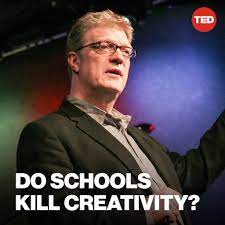Does Education Kill Creativity?

Do schools kill creativity? That’s the question that Sir Ken Robinson asks in his TED talk. The British educator and author was a pioneer in the development of creativity, innovation, and human resources. He also advised governments on cultural and creative education in Europe and Asia. Robinson’s TED talk has been viewed over 60 million times and has been viewed by people in 160 countries. We’ve discussed the importance of creativity in education before, but how can educators foster the right kind of education in their students?
Sir Ken Robinson’s 2006 TED talk
One of the most important things to consider in our education system is whether it is nurturing creativity. Our educational system is too rigid and linear. It rewards conformity over risk-taking, and rewards students for achieving the right results on tests rather than for being creative. Students in this test-heavy environment are afraid to take risks and focus on core subject matter instead. Fortunately, there are several things we can do to change the educational system to promote creativity.
Sir Ken Robinson, a British educator and writer, is an internationally recognized speaker and author. His TED talks have been viewed by more than 25 million people in more than 150 countries. One of his most influential TED presentations, he gave in 2006, has become the most popular of all time. Since its release, it has been viewed more than 380 million times online. This video is part of TED’s “Best of the Web” series.
Sir Ken Robinson’s latest book
Sir Ken Robinson is an internationally renowned writer and speaker. He is an advocate for creativity and innovation in education. His three TED talks on the subject have been viewed over 34 million times. The 2006 TED talk is the most-viewed presentation in history. In his latest book, does education kill creativity, he argues that we need to change our educational systems to allow children to grow as creative individuals.
The problem with Sir Ken Robinson’s book is that he leaves the door open to imposition as a viable future learning system. While the author recognizes that coercion kills creativity, he offers no practical solution. Coercion is a form of bullying fascism that produces dependent learners with no creativity. However, it is not the solution to solving the problem of serial killers.
Bill Gates’ TED talk on education
While many of us would love to see a school filled with children bursting with ideas, we’re faced with an unfortunate reality: less than 30% of kids graduate from high school. That figure is even worse if you exclude minority students. And while most of us can only dream of graduating from college, many of our low-income counterparts don’t get the chance. And they’re also at a much higher risk of spending their lives in jail. So, Bill Gates has a point.
While we all want our kids to be creative and innovative, our current educational system is simply not providing the tools necessary to teach students to become creative and productive. That’s where TED comes in. Bill Gates’ TED talk on education and creativity is a great example of how to do just that. The talks are full of data, video, humor, and anecdotes. They’re worth watching.
John Green’s TED talk
This TED talk on education and creativity is an important one. It addresses the importance of education and how we can improve it. It has been viewed over three million times on the TED website, but it does not appear to be available on YouTube. The talk starts with a story about a paper town and transitions into the concept of the “pressed value” of education. Students enter the educational system only to be drilled in things they have no interest in learning.
The traditional school system is an effective way to suppress creativity and lead to a stagnant society. Students are taught not to make mistakes, and they follow set paths and techniques. In order to achieve this goal, the traditional schooling system has to be changed. Instead of following a set path, they should allow their creativity to take over. This TED Talk has been viewed over three million times, and it demonstrates how to change the way we think about education and creativity.